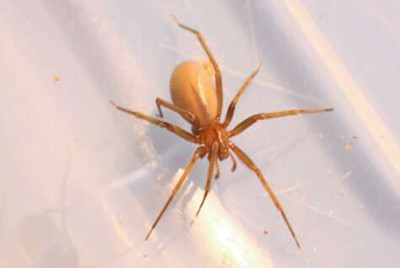
There are two characteristics that work together to make spider silk so strong and tough.
Hannes Schniepp says that the molecular structure of the protein from which the silk is spun—the first part of the spider's secret—is pretty well understood.
"Modern biology has given us the tools to run a sequence," Schniepp said. "But that's only one step."
Schniepp is an associate professor in William & Mary's Department of Applied Science. He and his lab have been working on reverse-engineering the second step: how the spider's spinner apparatus mechanically processes and organizes the protein. Some spiders have evolved organs to extrude strands that, for their size, are much stronger than steel. They have received new funding from the National Science Foundation to continue their research.
The lab focuses on brown recluse spiders, which Schniepp compares to the guild of legendary Asian swordsmiths.
"The smiths that worked for the samurai in Japan figured out a very complicated way of making blades that were better than any other sword," he said. "It was all in the way they treated the material.
"In the end, the blade is still made of iron and carbon—but if you treat them the right way, you get an outstanding product," he continued.
The Japanese swordsmiths didn't discuss the secrets of their craft and neither does the brown recluse. So the Schiepp lab uses an array of instruments and techniques to infer the spider's method from detailed, minute examination of the web material.
Schniepp and other material scientists are interested in learning the brown recluse's secrets as an essential first step to synthesizing the substance. He points out that his lab is also interested in other natural silks.
"The brown recluse spider as a really exciting model system that provides us unique insights into how silk works. And so far, we have focused strongly on the brown recluse," Schniepp said. "But we think what we can learn from the recluse applies to other silks as well—other spider silks and even silkworm silk. So we're kind of broadening our scope to get to get a more general understanding of silks—how they work, their inner mechanics."
He pointed out that there is a "huge spectrum" of possible uses for synthetic proteins inspired by the fibers produced by insects and arachnids. Materials based on natural substances are likely to be more environmentally sustainable than the current crop of plastics manufactured from fossil fuels. For example, Schniepp envisions a water bottle made of a protein.
"So you drink the water," he says. "And then when you're done, you can eat the bottle and get your daily dose of protein. Or you can just throw it outside and some animal will come along and eat it."
The dawning of the age of such useful synthetic substances is upon us, Schniepp said. He mentioned one startup company in California that's creating designer clothing—"expensive, with a very high price tag"—from a synthetic silk.
The goal of the Schniepp lab is to advance the understanding of the natural silks and how they're produced so that synthetic versions can be scaled up for mass production beyond boutique markets.
"You start by making small amounts," he said, "and they're naturally going to be expensive. But as you learn more, you learn to optimize and it gets cheaper and cheaper."
The Schniepp lab has been studying brown recluse spider silk for five years and it has made significant contributions to the unraveling of the spider's secrets. Their work has cleared the way for a better understanding of the silk of the brown recluse.
"Before, people had all kinds of complex models of what the silk fiber looks like and what makes a silk fiber so strong. But it was always very hard to confirm this directly," he said. "Experimental evidence was really sparse."
But the recluse makes a silk that has a different shape from other spiders, a fact that Schniepp's lab was able to use to figure out a new way of looking inside the silk strand structure. "And what we learned is that this ribbon is made up entirely of nanofibrils," he explained—strands that are 3,000 times thinner in diameter than a human hair.
They also reported that the silk is made up of individual nanofibrils laid in parallel—not twisted like strands of a rope. Another finding is that the brown recluse adds to the strength of the silk by spinning little loops into each strand.
The new NSF funding will allow the lab to continue their examination of the nature of nanofibrils, using advanced microscopy and spectroscopy. The goal is to complete the understanding of the silk, from the molecular level extending to the length of the entire silk fiber.
Members of the Schniepp lab include undergraduates as well as Ph.D. students at William & Mary. Schniepp says he will continue outreach programs to K-12 STEM students.
"We've had middle-school students in our lab. We offer summer internships to high school students; I had multiple students who did a one-year senior research internship from the Governor's School of Science and Technology in Hampton," Schniepp said. "We can really reach out to people at all levels and get them excited about this research and maybe influence some of them to choose a career in STEM and help advance these new technologies."

